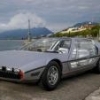The wheel-driven LSR set by the Summers Brothers’ Goldenrod stood for perhaps longer than any other similar record, but it is not for that reason that I thought of starting this thread.
Like so many of its predecessors, such as the Silver Bullet, Thunderbolt and Challenger, Goldenrod was equipped with multiple engines (four in this case) to provide the necessary power, and, like some of them, four-wheel-drive to reliably transmit that power to the ground, without wheelspin. There is interesting variation, in these and other examples, in the manner of coupling together the engine outputs to achieve this.
Goldenrod has all four engines in line, but not all facing the same way. Counting from the front, the first faces forward, as is usual, but the second faces backward, i.e., with the output at what is now its front end. Similarly with the third and fourth engines. This is so that the combined output from engines 1 & 2 passes through a single gearcase to the driveshaft (propeller shaft) running down the left side of the car, and ultimately to the front and rear drives. Likewise for the combined output from engines 3 & 4.
Now when an engine is turned back-to-front, its rotation is reversed, as far as the vehicle is concerned, and necessary provision must be made, in the engine itself or in the transmission, to obtain the correct direction of rotation for the driving wheels.
I have been wondering how it was done for Goldenrod. Was an extra gearwheel interposed in the drive to the propeller shaft? Or was the direction of rotation of engines 2 and 4 reversed? This latter might have involved the manufacture of “mirror image” crankshafts and camshafts, special bearings with relocated oil holes, changes to pumps and magnetos or distributors, and so on. Formidable tasks, but well within the capabilities of the US automotive industry which built those mighty Hemis anyway.
Or, perhaps, there was yet another way. For instance, engines 2 and 4 might have special crankshafts which provided the output from what is normally the free end.
Anyone know the answers? Thanks in advance.















